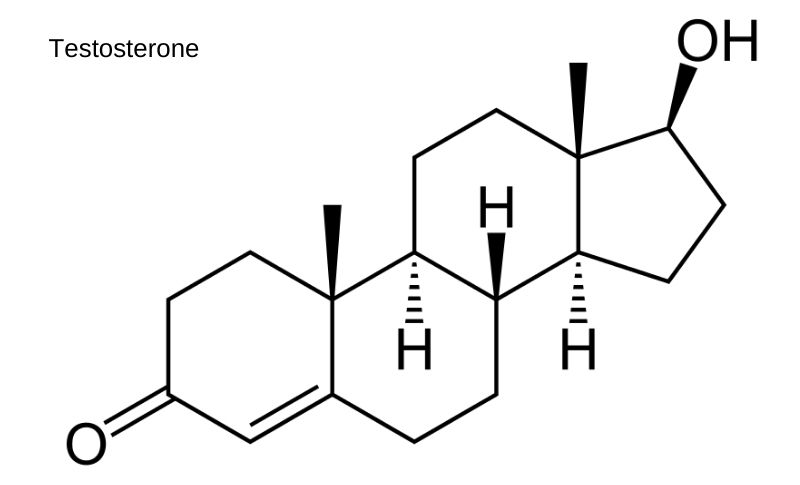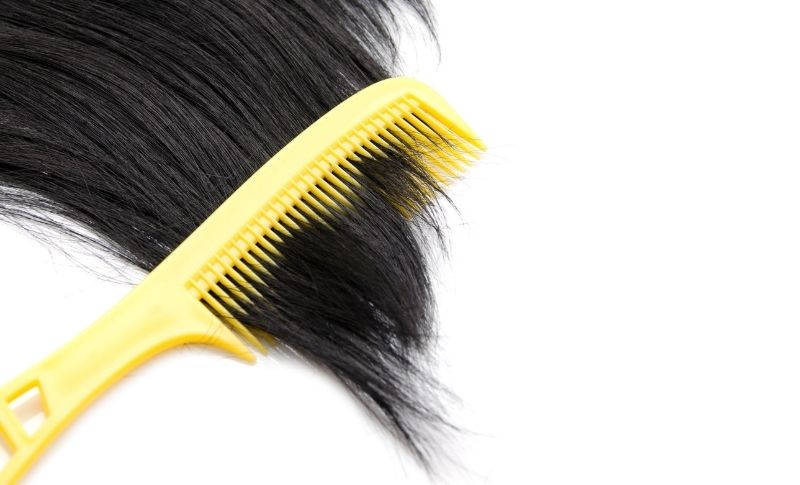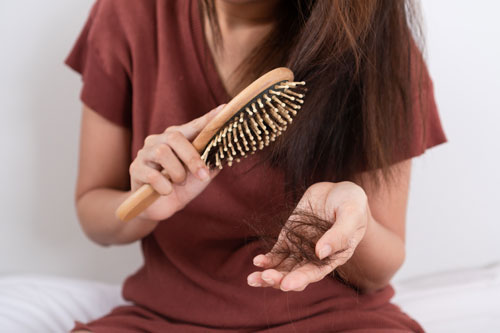Androgen hormones in female androgenetic alopecia
The accepted view of the relation between androgens and androgenetic alopecia is that hyperandrogenism is more commonly associated with a male pattern of balding, i.e. frontal recession and vertex balding. However, many hyperandrogenic women show a female pattern of hair loss and those with a male pattern do not always have androgen excess.

The exact roles of androgen over-production, activity, and androgen receptors in androgenetic alopecia in women are still unclear. Although it is rather evident that testosterone is necessary for the development of male balding, there are no systematic studies to support the same in women. However clinical experience suggests that balding is common in women with hyper-androgenism, especially when it is accompanied by other signs of androgen excess such as irregular menstruation, infertility, hirsutism (increased secondary sexual and facial hair), acne, and oily skin.
The type and proportion of the various androgens produced, both centrally and peripherally are different in men and women. Approximately 30 percent of a woman’s testosterone is produced in the ovaries; the other 70 percent is derived from the transformation of adrenal androgen precursors such as dehydro epiandrosterone (DHEA) and androstenedione, both of which decline with age.
The overall production of testosterone by the ovaries is far less than that of the testes, resulting naturally in a much lower plasma level of testosterone in women than in men. However, the more abundant weak androgens serve as a source of precursors for potent androgens, which provide the physiologic or pathophysiologic androgen activity. Only a small fraction of androgens exists as free steroids in the circulation, with equilibrium between free hormones and protein-bound androgens.

Therefore, in some women there may be hyper secretion of androgens like androstenediol or testosterone, or DHEA or androstenedione by the adrenal gland or ovary. The skin is capable of synthesizing active androgens from the systemic precursor DHEA sulfate. Interconversion of these hormones at the level of the hair follicle leads to increased tissue levels of the active hair follicle androgen, dihydrotestosterone (DHT). DHT is a potent stimulator of hair loss in the scalp.
The most important protein for androgen binding is sex-hormone binding globulin (SHBG). Sex hormone-binding globulin is a glycoprotein synthesized by the liver. Many studies show that SHBG levels co-relate inversely with the severity of the alopecia. The more potent androgens and estradiol are bound in the plasma to SHBG, although the binding affinities differ. In DHT, the affinity is three times that of testosterone and nine times that of estradiol. Elevated testosterone causes SHBG synthesis to decrease, in addition to an increased activity of 5 -Reductase, the enzyme responsible for the metabolism of testosterone to DHT.
Androgen excess has been evaluated most extensively in hirsutism. The ovary is the predominant source of androgen production in most women with functional hyperandrogenism. Gonadotropin-releasing hormone (GnRH) is a hormone made by the hypothalamus of the brain, and causes the pituitary gland to make luteinizing hormone (LH) and follicle stimulating hormone (FSH). Both these hormones are involved in reproduction. In most women with ovarian hyperandrogenism, the pituitary is more sensitive to GnRH and there is increased LH and decreased FSH secretion by the pituitary, which leads to increased androgen production and anovulation (failure of the ovaries to produce or release mature eggs).

Studies show a relation between polycystic ovarian syndrome and androgenetic alopecia. The deficiency of two key enzymes for biosynthesis of estrogen may be present in polycystic ovarian syndrome. This results in a buildup of androgens and the decreased production of estrogen by the ovaries. Additionally, Polycystic Ovary Syndrome involves increased insulin levels, which has an affect on hormone production and SHBG.
Hyperprolactinemia is a condition characterized by elevated serum levels of the hormone prolactin in non-pregnant individuals, and is a possible cause of adrenal overproduction of androgens. Hyperprolactinemia should be considered in women with extensive or rapidly progressive pattern hair loss. Women with hyperprolactinemia have an increase in free testosterone, a decrease in SHGB, and a moderate increase in DHEAS. Prolactin modifies ovulation by blocking the response of the gonads to LH and preventing the positive feedback of estrogen in promoting the ovulatory LH surge. Consequently, less estradiol and more androstenedione are produced.
Research outcomes
Several researchers have examined circulating androgen levels in women with scalp hair loss, and there is little doubt of the androgen-dependent nature of pattern hair loss seen in some women with marked androgen excess, either exogenous or endogenous. Experimental studies show that women often precipitously lose hair in a typical Hamilton-IV pattern with a deep bi-temporal recession, and their hair loss may improve when the precipitating cause is removed. The hair loss in women with hirsutism, acne, and female pattern hair may respond to antiandrogen therapy, substantiating the theory of androgen dependence in some women with female pattern hair loss.

On the other hand, some observations have further questioned the role of androgens in female pattern hair loss. Norwood described families where female pattern hair loss appeared to be inherited independently of male balding and in a single case report female pattern hair loss occurred in a young woman who lacked circulating androgens or other signs of postpubertal androgenization. The 5α-Reductase inhibitor and Finasteride, is effective in the treatment of male balding but, in a randomized controlled trial, failed to prevent the progression of hair loss in postmenopausal women with female pattern hair loss and normal androgen levels.
Conclusion
Most women with female pattern hair loss, however, do not have any signs or symptoms of hyperandrogenemia, and serum testosterone levels in such women are typically normal. Definitely there are reports of varying percentages of women with female pattern hair loss who have elevated androgens, but this does not clearly mean that female hair loss pattern is androgen dependant. Observations made by researchers collectively suggest that androgens play a role in female pattern hair loss but that androgen-independent mechanisms could also be involved in some women. Therefore, the relationship between systemic elevated androgen levels and alopecia in women is difficult to determine, leaving the condition to be called idiopathic in most women, as suggested by some authors.




